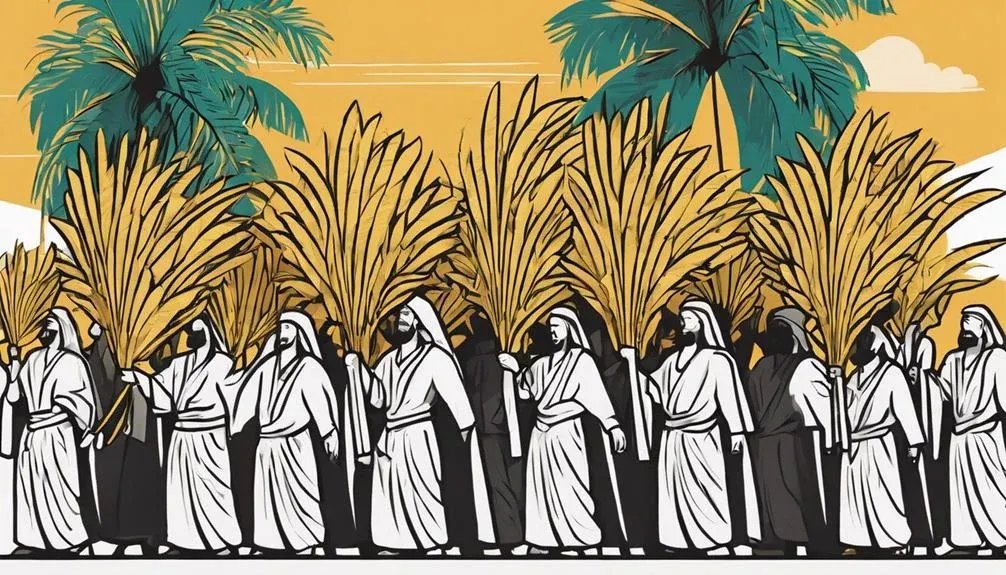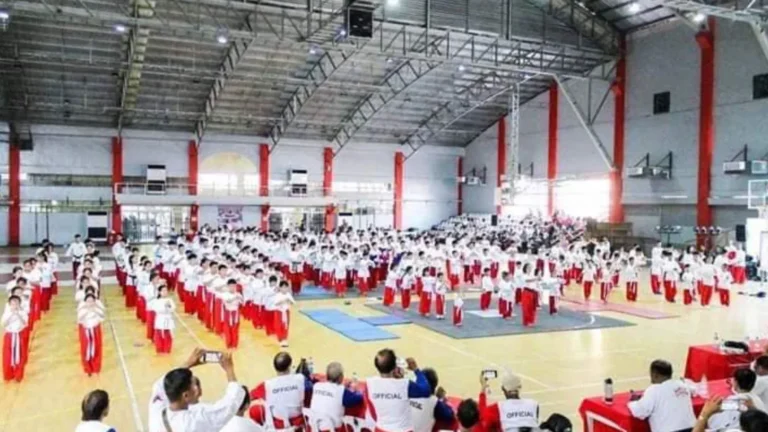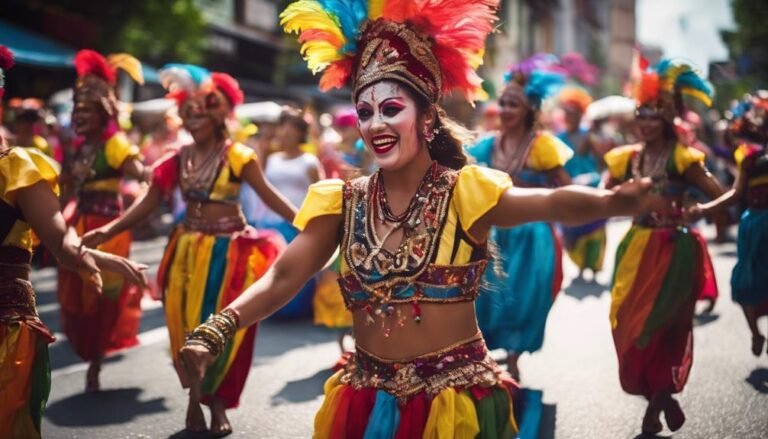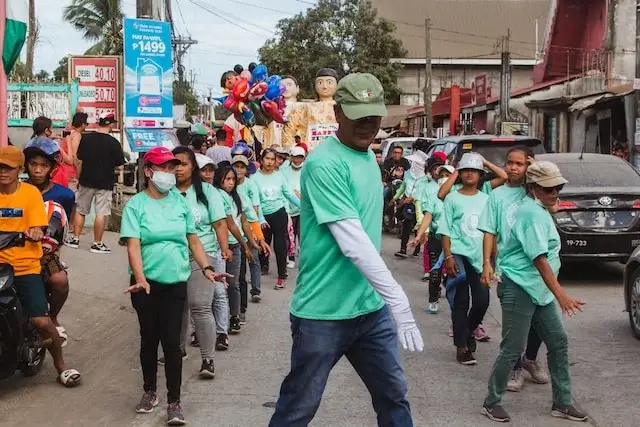Easter Celebrations in the Philippines

Easter celebrations in the Philippines are marked by various traditions and rituals. The week before Easter, known as Holy Week, is a time for atonement and reflection. On Palm Sunday, Filipinos buy coconut leaves as a substitute for palm leaves and get them blessed.
During the week, various rituals are observed, such as the “Pabasa” (continuous chanting of the Passion of Christ) and “Visita Iglesia” (visiting seven different churches on Maundy Thursday). Good Friday is a day of mourning and meditation, and on Black Saturday, the Easter Vigil, Visita Iglesia, Stations of the Cross, and confessions are all part of the traditions. Easter Sunday is the main day of celebration, known as “Pasko ng Pagkabuhay” or “Feast of the Resurrection.”
The day begins with the “Salubong” (welcoming), a procession involving statues of Jesus and the Virgin Mary. Easter egg hunts are also a popular tradition, where children search for coloured eggs near churches or in shopping malls.
The Philippines is a predominantly Catholic country, and Easter is a significant religious and cultural holiday for Filipinos
Key Takeaways
- Holy Week in Filipino culture is deeply rooted in religious traditions and societal practices.
- Traditional Easter customs in the Philippines blend religious fervor with community celebrations.
- Easter egg hunts add vibrancy to celebrations, fostering unity within communities.
- Church processions during Easter attract large crowds and serve as community focal points.
Easter Celebrations in the Philippines At A Glance
Creating a detailed table with the requested specifications about Easter Celebrations in the Philippines involves a considerable amount of information. Given the complexity and the breadth of information required, I’ll focus on a well-known Easter celebration known as the “Moriones Festival” to illustrate the format and content you’re asking for.
| Facts | Brief Explanation |
|---|---|
| Name of the Festival | Moriones Festival |
| Type of Festival | Religious, Cultural |
| City of Origin | Marinduque |
| Festival Etymology | The name “Moriones” refers to the masked and costumed penitents who march around the town for a week. |
| Date when it was celebrated first | 1960s |
| Dates when this festival is celebrated every year | Holy Week (March or April, varies each year) |
| Founder of the Festival | Community leaders of Marinduque |
| Brief history of the festival | The Moriones Festival commemorates the life of Saint Longinus, a Roman centurion who was blind in one eye. The festival blends Roman and Christian traditions, showcasing locals in vibrant costumes and masks to mimic Roman soldiers as described in the Passion of Christ. It began in the 1960s as a local tradition that has since gained national and international recognition. |
| Brief history of the city where it is celebrated | Marinduque, a heart-shaped island province in the Philippines, is known for its rich cultural heritage and history. It has been inhabited since prehistoric times, with significant development during the Spanish colonial era. The province is considered the geographical center of the Philippines. |
| Ethnic information of the city and region | The population is predominantly Tagalog, sharing cultural and linguistic ties with the major ethnic group of the Philippines. |
| Location of the city in the country | Marinduque is located in the Southern Tagalog region, at the heart of the Philippine archipelago. |
| How to reach the city | Access to Marinduque is typically via a flight to Marinduque Airport or by ferry from Lucena City to the ports of Balanacan in Mogpog or Cawit in Boac. |
| Nearby and surrounding cities or towns and their distance from the city of the festival | – Boac (capital) – 6 km – Santa Cruz – 20 km – Gasan – 8 km |
| Google map link to the city location | Google Maps Link |
| Main events and activities | – Mask-making workshops – Street parades featuring Moriones costumes – Religious reenactments of the Passion of Christ – Visita Iglesia (church visits) |
| Famous tourist attractions and landmarks in the city | Boac Cathedral – A historical church with significant religious and cultural value. Tres Reyes Islands – Known for beautiful beaches and snorkeling spots. Bathala Cave – A mystical cave explored for its natural formations. |
| Famous food dishes of the city | Pancit Marinduque – A local noodle dish with a unique flavor. Arrowroot cookies (Uraro) – Traditional cookies made from the arrowroot plant. |
| Related festivals in the same region | Pahiyas Festival – A harvest festival in Lucban, Quezon. Ati-Atihan Festival – A feast in honor of the Santo Niño held in Kalibo, Aklan. |
Holy Week Significance in Filipino Culture
Holy Week holds immense significance in Filipino culture, deeply ingrained in the country’s religious traditions and societal practices. The Filipino traditions during Holy Week are a rich fabric of customs that reflect the country’s strong Catholic influence. This period, starting from Palm Sunday to Black Saturday is marked by solemn observances and religious rituals that are deeply intertwined with Filipino identity.
One of the most prominent cultural significances of Holy Week in the Philippines is the reenactment of the Passion of Christ through processions and plays known as ‘Pabasa’ or ‘Senakulo’. These dramatic presentations are not only religious events but also serve as a way for communities to come together and strengthen their bonds.
Additionally, Filipinos engage in acts of penance such as fasting, abstinence, and attending church services daily as a form of spiritual reflection and preparation for Easter Sunday. These traditions showcase the deep-rooted faith and cultural heritage of the Filipino people during this sacred week.
Traditional Easter Customs in the Philippines
Steeped in a rich mosaic of cultural heritage, traditional Easter customs in the Philippines showcase a unique blend of religious fervor and community celebration. During this time, the country comes alive with various practices that have been passed down through generations, reflecting a deep connection to faith and community.
- Easter Parades: Communities across the Philippines organize vibrant Easter parades, where religious icons and symbols are beautifully displayed, accompanied by prayers and hymns.
- Religious Traditions: Filipinos engage in a series of religious ceremonies and processions, such as the “Salubong,” reenacting the meeting of Jesus and Mary after the resurrection.
- Family Gatherings: Easter serves as a time for families to come together, sharing special meals and attending church services in unity.
- Cultural Practices: Traditional dances and music performances are common during Easter, showcasing the cultural diversity and richness of the Filipino people.
These customs not only strengthen the bond within families but also reinforce the cultural identity of the Filipino community, making Easter a deeply cherished and significant time in the country.
Easter Egg Hunts and Festivities
Easter egg hunts and festivities in the Philippines add a vibrant and joyous element to the traditional celebrations, engaging both young and old in a lively pursuit of colorful eggs and festive activities. Community gatherings are a common sight during Easter, with neighbours coming together to organize egg hunts for the children.
This fosters a sense of unity and belonging within the community, strengthening social ties. Families often spend time egg decorating, a cherished tradition where intricate designs and vibrant colors adorn the eggs, symbolizing new life and rebirth.
In addition to the egg hunts, festive parades are a highlight of Easter celebrations in the Philippines. These parades feature colorful floats, traditional costumes, and lively music, creating a jubilant atmosphere for all participants. Families bond over these parades, enjoying the spectacle together and creating lasting memories.
The combination of community gatherings, egg decorating, family bonding, and festive parades makes Easter in the Philippines a truly special and joyous occasion for all.
| Community Gatherings | Egg Decorating |
|---|---|
| Neighbors come together to organize egg hunts | Cherished tradition of intricate egg designs |
| Fosters unity and social bonds | Symbolizes new life and rebirth |
Church Role and Religious Processions
Amidst the vibrant Easter celebrations in the Philippines, the role of churches and religious processions stands as a cornerstone of the deeply ingrained cultural and spiritual fabric of the country. The Church plays an essential role during Easter, offering a place for worshippers to gather and reflect on the significance of the season.
Religious processions are a common sight during Holy Week, with devotees marching through the streets, carrying statues and crosses, reenacting the events of Jesus’ crucifixion and resurrection.
- Church processions are a significant part of the Easter tradition in the Philippines, with different parishes organizing their processions throughout Holy Week.
- These processions often attract large crowds of spectators who come to witness the solemn yet visually engaging displays of faith and devotion.
- Religious traditions such as the ‘Senakulo,’ a reenactment of the Passion of Christ, are performed in many communities, drawing participants and onlookers alike.
- The Church’s involvement in Easter celebrations extends beyond just religious services, as it serves as a focal point for community gatherings and shared experiences of faith.
Unique Easter Foods in Filipino Tradition
Exploring the rich mosaic of Filipino culinary heritage during Easter reveals a fascinating array of unique and traditional foods that hold deep cultural significance. Filipino delicacies play a central role in Easter feasts, reflecting a blend of indigenous flavors and Spanish influences.
- One such delicacy is ‘bibingka,’ a rice cake cooked over hot coals and topped with salted duck eggs and coconut shavings.
- ‘Puto bumbong’ is another favorite, a purple rice cake steamed in bamboo tubes and served with butter or sugar.
- During Easter, ‘suman’ is a must-have, a sticky rice cake wrapped in banana leaves.
- Families also enjoy ‘pancit malabon,’ a noodle dish with shrimp, eggs, and a savory sauce, symbolizing abundance and prosperity.
- ‘Lechon’ is a popular centrepiece for Easter gatherings, a whole roasted pig with crispy skin and tender meat, symbolizing celebration and bounty.
- ‘Kakanin’ like ‘sapin-sapin’ and ‘puto’ are colorful rice cakes that add a festive touch to the Easter table.
These unique Easter foods not only satisfy taste buds but also reinforce cultural traditions and strengthen family bonds during this significant holiday.
Frequently Asked Questions
How Do Filipinos Typically Prepare for Easter Celebrations in the Weeks Leading up to Holy Week?
As Easter approaches, Filipinos ardently anticipate the upcoming celebrations by engaging in various cultural traditions. From attending church services to participating in community events, Filipino Easter preparations reflect the deep significance of this holiday in their culture.
Are There Any Specific Superstitions or Beliefs Surrounding Easter in Filipino Culture?
In Filipino culture, superstitions and beliefs surrounding Easter are deeply rooted. Cultural practices intertwine with folklore during Easter celebrations, reflecting a blend of tradition and spirituality. These beliefs play a significant role in shaping community rituals.
What Are Some Lesser-Known Community Events or Public Celebrations That Take Place During Easter in the Philippines?
During Easter in the Philippines, lesser-known community events include vibrant parades with intricately designed floats and cultural festivals showcasing traditional dances and music. These gatherings foster a sense of unity and celebration among locals.
How Do Filipino Families Typically Incorporate Easter Traditions Into Their Daily Lives Beyond the Religious Aspects?
In Filipino families, Easter traditions blend seamlessly into daily life. From preparing special meals to engaging in cultural celebrations, these practices strengthen family bonds. Such customs are not just rituals but integral parts of familial connection.
Are There Any Modern Adaptations or Changes to Traditional Easter Celebrations in the Philippines That Are Becoming More Popular in Recent Years?
In recent years, modern adaptations to traditional Easter celebrations in the Philippines have included incorporating social media campaigns, virtual religious services, and online Easter egg hunts. These changing traditions reflect the evolving digital landscape.
Conclusion
To wrap up, Easter celebrations in the Philippines hold a deep cultural and religious significance, with Holy Week being a time of reflection and devotion for many Filipinos. Traditional customs, church processions, and unique foods all play a role in the festivities, bringing families and communities together. Through Easter egg hunts and public events, the spirit of joy and renewal is shared among all, strengthening the bonds of family and faith in the Filipino tradition.




